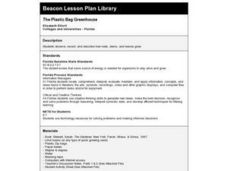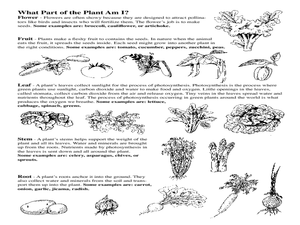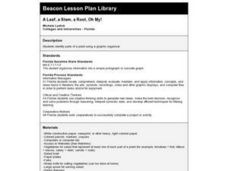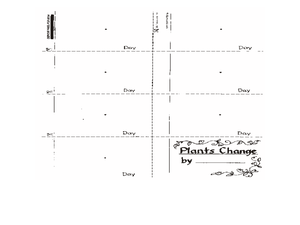American Museum of Natural History
Be a Water Saver
Everyone must do their part to make a difference. The lesson link provides an 11-item questionnaire to reflect on conservation practices. Simple and straightforward, the lesson is perfect as a remote learning resource or as a tool for an...
Wilderness Classroom
Pollution
Educate scholars on pollution—air, water, and land—with a series of lessons that begin with a thorough explanation of each type. Learners then take part in three activities to reinforce the importance of reducing pollution. They...
NOAA
Plankton
Dive into the world of plankton. The 17th installment of a 23-part NOAA Enrichment in Marine sciences and Oceanography (NEMO) program introduces different types of plankton. Young scientists then use what they have learned to classify...
National Institute of Open Schooling
Coordination Compounds
Cyanide, a coordination compound, is used in the extraction of gold and silver. Part 24 in the series of 36 delves into the world of coordination compounds. Classes learn, through readings, discussions, and answering questions, how to...
Kenan Fellows
Unit 3: How Drugs Enter/Exit the Body
The third of a four-part series on Pharmacology teaches scholars how drugs enter and exit the body, how they act inside the body, how they affect the brain, and more. Over the course of the unit, groups complete two labs and one...
PBS
Reading Adventure Pack: The Snowy Day
Scholars listen to a read-aloud of fiction and nonfiction books, The Snowy Day, written and illustrated by Ezra Jack Keats, and Snow Is Falling, written by Franklyn Branley and illustrated by Holly Keller, then take part in four creative...
Curated OER
The Plastic Bag Greenhouse
Third graders observe plants and record their growth. They describe the parts of plants in detail including the roots, stems and leaves.
Curated OER
Introduction To Floral Morphology
Students create a model of the four basic whorls of flowers using a water bottle, construction paper and Q-tips. They then examine fresh flower specimens to see how the basic structure can vary in different species of flowering plants.
Curated OER
Plant Party
Young scholars identify plant parts. In this plants lesson, students bring in a vegetable. Each student classifies which part of the plant their vegetable comes from (flower, root, ect.) Young scholars identify the parts of their...
Curated OER
Caterpillar Camouflage
Students list animals, plant parts, and reasons for caterpillars to camouflage themselves. In this animal and plant adaptations lesson plan, students also play a game where they use colors as camouflage.
Curated OER
A Botanists View
Students explore plant and seed structure. They dissect a seed and identify its parts. In addition, they explain the function and compare and contrast monocotyledon and dicotlyledons.
Curated OER
How Does Your Garden Grow?
Students explore plant life by reading books about gardening. In this botany lesson plan, students read the books From Seed to Plant and Oh Say Can You Seed? while identifying the necessary elements to raising a healthy plant. Students...
Curated OER
Getting a Handle on Your Bee
Middle schoolers observe dried bees, carefully glue them to toothpicks, and use them for cross pollinating their Brassica plants. They also describe reasons why two similar investigations can produce different results. Finally,...
Curated OER
The Seed Match
Students study seeds and plants. In this science lesson plan, students explore seeds from various types of plants and complete a worksheet about seeds. Students discuss plants that are fruits and vegetables and where they grow.
Curated OER
Looking at Flowers
Young scholars use their bee sticks to cross-pollinate their Fast Plants and also focus in on the anatomy of flowers. They analyze how the parts of a system go together, and how these parts depend on each other. Finally, students...
Curated OER
A Leaf, a Stem, a Root, Oh My!
Students conduct Internet research on plants and complete a WebQuest on vegetable plants. They use a graphic organizer to display their findings, observe actual vegetables and design a salad, noting which part of each plant is included.
Curated OER
Plant Classfications
Seventh graders observe and discuss as a class the different types of vascular plants. They examine the different parts of the plant and some of the processes occurring in plants with activities accompanying.
Curated OER
From McGee's Farm to the Movies
Students participate in several plant-themed activities. They keep a food log, identify any plants they have eaten and then classify these foods by the part of the plant that is edible. Students sing songs about plants, make collages,...
Curated OER
Rain Reasons
Students explore how climatic factors influence the growth of plants. They create an experiment to find how variations in water, light, and temperature affect plant growth and describe how precipitation and geography can affect the...
Curated OER
Making Pretzels
Students discover that plants provide food products to humans. In this baking lesson, students grind wheat seeds into flour and then use the flour to make pretzels. Students participate in a variety of activities that involve them in...
Curated OER
Plant Science: Introduction to Photosynthesis
Students explore the process of photosynthesis in plants. They discuss the purpose of photosynthesis and its components. Students discuss the importance of photosynthesis for plants and they examine the parts of the plant that play an...
Curated OER
Plant Seedling
Students label seed parts and plant seeds. In this seeds lesson plan, students observe and learn about how seeds play a huge role in all plants and food.
Curated OER
Pollination Station
Students investigate why and how bees pollinate flowers and other plants. They define pollination, and read and sing along with the song "Yo, i'm a Flower." Students examine a diagram of a flower, simulate bees pollinating flowers, and...
Curated OER
Desinging and Using a Dichotomous Key
Young scholars are examine the purpose of dichotomous keys. In groups, they design their own in order to describe the characteristics of plants and weeds native to California. To end the lesson, they define new terminology associated...
Other popular searches
- Parts of Plants
- Identifying Parts of Plants
- Parts of Plants Video
- Parts of Plants Organizer
- Reproductive Parts of Plants
- Parts of Plants Cell
- Comparing Parts of Plants
- Parts of Plants Mnemonic
- Edible Parts of Plants
- Comparing Plants Plant Parts
- Parts of a Plants
- Plants Parts for Food























